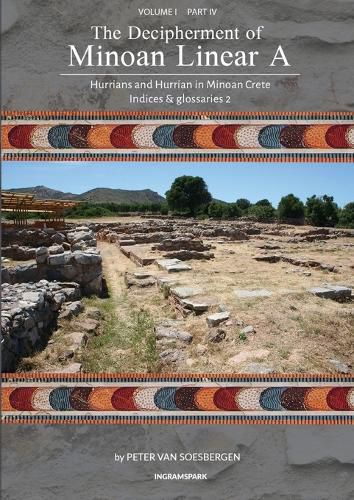Readings Newsletter
Become a Readings Member to make your shopping experience even easier.
Sign in or sign up for free!
You’re not far away from qualifying for FREE standard shipping within Australia
You’ve qualified for FREE standard shipping within Australia
The cart is loading…






This title is printed to order. This book may have been self-published. If so, we cannot guarantee the quality of the content. In the main most books will have gone through the editing process however some may not. We therefore suggest that you be aware of this before ordering this book. If in doubt check either the author or publisher’s details as we are unable to accept any returns unless they are faulty. Please contact us if you have any questions.
THE DECIPHERMENT OF MINOAN LINEAR A - VOLUME I - PART IV It is significant that at least three toponyms can be recognized in the Messara-valley that have a Hurrian origin. The oldest is Linear A pa-i-to (HT 97a.3; HT 120.6). It is a genuine Hurrian toponym meaning 'He/She (a God/the King) has built (the palace)' and it is equivalent to Old Hurrian ba-'a-as-to/um in the Tis-atal inscription, analysed and normalised as pa=ast=o=m, and translated as 'He (Tis-atal) has built (a temple)', cf. Th. Richter (BGH, 285-286), s.v. pa-, pa?- II [passim] 'to build', pa('/h)-, cf. G. Wilhelm, 1988b, 55. The following phases of phonetic development are likely: ba-'a-as-to/um = pa('/h)=ast=o=m > pa=j=ast=o=m > pa=j=(a)st=o=m > pa=j=st=o=m (wr. pa-i-to in Linear A). Transitional glide -j- (-i- in Linear A pa-i-to) distinguished -a- of the root pa- from the -a- of root-extension -ast- and eventually the -a- of -ast- disappeared as a result of syncope. For Linear B pa-i-to (KN Da 1163+1400, al.) the Old Hurrian ending in =o=m had to be changed into a Hellenized form in -o? (-os): ??????? (Phaistos). The ancient name of the palace of Hagia Triada, ka-pa (frequent in Linear A, but only at Hagia Triada), was the first Hurrian toponym detected in Linear A and interpreted as ?alba, Hurrian name of Aleppo (?alab in Semitic) with the Linear A ethnic ka-pa-qe (HT 6a.4-5) = syllabic cuneiform ?alba?e = alphabetic cuneiform ?lbg 'Man of ?alba', 'Man of Aleppo' (Hurrian ethnic suffix -?e). Toponym ka-pa and ethnic ka-pa-jo (with Greek ethnic suffix -yo?) were already known from the Linear B tablets from Knossos. Linear A ku-mi (HT 110a.1) may well be the Minoan-Hurrian toponym Kummi, present Kommos, the Minoan harbour of Phaistos and Hagia Triada on the south coast of Crete, recently excavated by the Canadian G. Cadogan and his team. Cretan Kummi is probably derived from the name of the city of Kumma/e/i or Kummiya in Anatolia, derived from Hurrian kum- 'to build / erect / pile up'. If this identification is correct, it is after ka-pa = ?alba (present Hagia Triada) the second Cretan site named after a famous predominantly Hurrian city in the Near East.
$9.00 standard shipping within Australia
FREE standard shipping within Australia for orders over $100.00
Express & International shipping calculated at checkout
This title is printed to order. This book may have been self-published. If so, we cannot guarantee the quality of the content. In the main most books will have gone through the editing process however some may not. We therefore suggest that you be aware of this before ordering this book. If in doubt check either the author or publisher’s details as we are unable to accept any returns unless they are faulty. Please contact us if you have any questions.
THE DECIPHERMENT OF MINOAN LINEAR A - VOLUME I - PART IV It is significant that at least three toponyms can be recognized in the Messara-valley that have a Hurrian origin. The oldest is Linear A pa-i-to (HT 97a.3; HT 120.6). It is a genuine Hurrian toponym meaning 'He/She (a God/the King) has built (the palace)' and it is equivalent to Old Hurrian ba-'a-as-to/um in the Tis-atal inscription, analysed and normalised as pa=ast=o=m, and translated as 'He (Tis-atal) has built (a temple)', cf. Th. Richter (BGH, 285-286), s.v. pa-, pa?- II [passim] 'to build', pa('/h)-, cf. G. Wilhelm, 1988b, 55. The following phases of phonetic development are likely: ba-'a-as-to/um = pa('/h)=ast=o=m > pa=j=ast=o=m > pa=j=(a)st=o=m > pa=j=st=o=m (wr. pa-i-to in Linear A). Transitional glide -j- (-i- in Linear A pa-i-to) distinguished -a- of the root pa- from the -a- of root-extension -ast- and eventually the -a- of -ast- disappeared as a result of syncope. For Linear B pa-i-to (KN Da 1163+1400, al.) the Old Hurrian ending in =o=m had to be changed into a Hellenized form in -o? (-os): ??????? (Phaistos). The ancient name of the palace of Hagia Triada, ka-pa (frequent in Linear A, but only at Hagia Triada), was the first Hurrian toponym detected in Linear A and interpreted as ?alba, Hurrian name of Aleppo (?alab in Semitic) with the Linear A ethnic ka-pa-qe (HT 6a.4-5) = syllabic cuneiform ?alba?e = alphabetic cuneiform ?lbg 'Man of ?alba', 'Man of Aleppo' (Hurrian ethnic suffix -?e). Toponym ka-pa and ethnic ka-pa-jo (with Greek ethnic suffix -yo?) were already known from the Linear B tablets from Knossos. Linear A ku-mi (HT 110a.1) may well be the Minoan-Hurrian toponym Kummi, present Kommos, the Minoan harbour of Phaistos and Hagia Triada on the south coast of Crete, recently excavated by the Canadian G. Cadogan and his team. Cretan Kummi is probably derived from the name of the city of Kumma/e/i or Kummiya in Anatolia, derived from Hurrian kum- 'to build / erect / pile up'. If this identification is correct, it is after ka-pa = ?alba (present Hagia Triada) the second Cretan site named after a famous predominantly Hurrian city in the Near East.